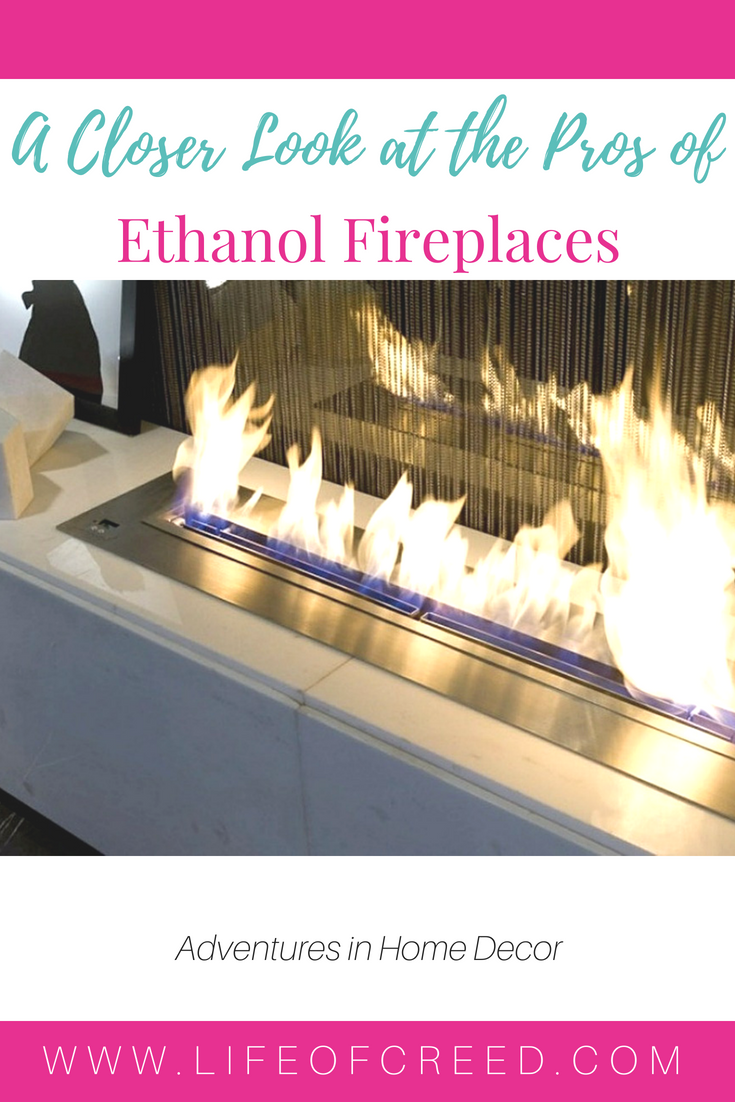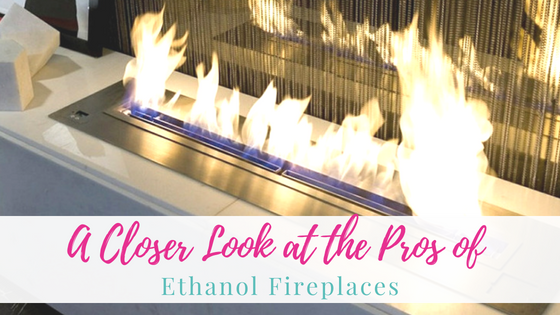Ethanol fireplaces provide a number of benefits when compared to other heating sources. The section below takes a closer look at these benefits.

Low Pollution
Wood-burning fireplaces put off smoke that contains potentially harmful toxins and other chemicals that can pollute the air and degrade indoor air quality. in order to effectively keep this smoke from entering your home, the stove or fireplace needs to be attached to a chimney.
With ethanol, on the other hand, you don’t have to worry about installing a chimney since the fuel itself is extremely clean burning. Keep in mind, however, that you still do need to provide the fire with oxygen. Make sure there is plenty of fresh air in the room by cracking a window or leaving the door to the room ajar. Always read the instructions from the manufacturer so that you can be sure you are using the fireplace safely.
No Mess To Deal With
Traditional wood-burning fireplaces are messy to deal with since they leave behind a lot of ash, creosote, and other messy substances. Ethanol fireplaces, on the other hand, are completely mess-free, meaning that you don’t have to spend your time dealing with cleaning and maintenance.
Fuel That Is Simple To Store
Firewood takes up a lot of space, is difficult to stack, and tends to attract insects and rodents. Bio-ethanol fuel, on the other hand, comes in compact quart-sized containers which can be neatly stacked in your home. You can purchase this fuel at just about any store that sells items for the home.
Portable For Use Inside or Outside Your Home
Because ethanol fireplaces can be easily moved, you can use them indoors or out. You also have the flexibility to place your fireplace wherever you want inside your home. You can use it on your porch or deck, mount it on a wall, or place it in your living room. This makes these fireplaces a lot more versatile than traditional fireplaces.
Keep in mind, however, that fireplaces that burn bio-ethanol fuel don’t give off a lot of heat. You usually will need to use them in conjunction with another source of heat if you want to combat cold temperatures.
An Eco-Friendly Option
Not only does bio-ethanol reduce reliance on fossil fuels but it also helps minimize the number of trees that are cut down each year.
Very Little Risk of Fire
To use an ethanol fireplace, all that you have to do is add fuel and light it using a long fireplace lighter. Once the fire is lit, you don’t have to worry about it popping or shooting sparks or embers across your room like you would with a traditional wood-burning fireplace. Just make sure that all excess ethanol fuel is safely out of the area before lighting the fire.
Simple To Douse The Fire
All that you have to do to shut off the flame is use the attached snuffer, making it easy to douse the fire when you are done using your fireplace. Try to avoid leaving a lot of fuel in the unit. Otherwise, the fuel can quickly evaporate.
A Clean, Modern Look
Most fireplaces that burn bio-ethanol fuel are designed to look extremely modern. You can use them to enhance your decor, creating a space where you can gather together with your loved ones and enjoy the soft glow of a fire.
Low Installation Costs
Typically, biofuel fireplaces for the home don’t have any extra expenses associated with installation. Because they sit on a table or are simply hung on the wall, you don’t have to make major changes to your home like you would if you were installing a traditional fireplace.
If you are installing an ethanol insert in an existing fireplace, there are some installation expenses that you will need to cover. In most cases, however, these expenses are far lower than installing other types of fireplaces or inserts.
Final Overview
Ethanol fireplaces provide a lot of advantages over other types of fireplaces. Like all fireplaces, they do have a few minor drawbacks. All in all, however, they are an excellent choice for any home.
About the Author

Guest Blogger
This blog post was written by a guest blogger.



We don’t have a fireplace right now, but are dying for one in the future…ethanol sounds like the right choice!
I don’t think I’ve ever used an ethanol fireplace, but the pros of one sound awesome. I have always been freaked out by lighting or having a wood burning fireplace, this seems like a great compromise since I do enjoy a good fireplace.